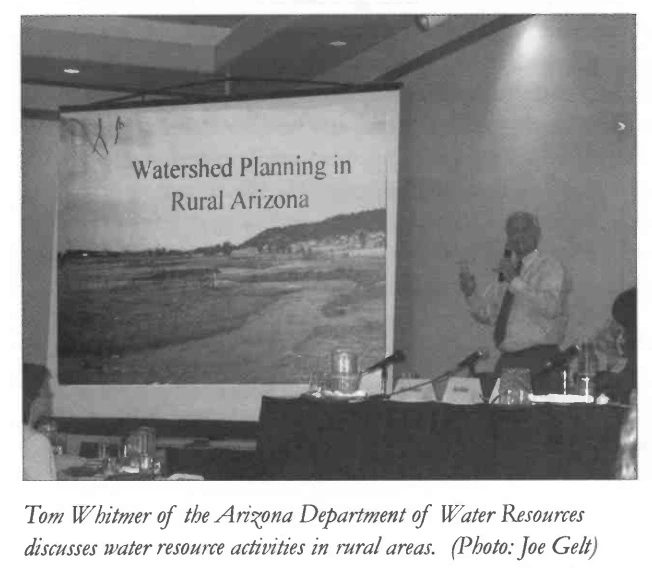
As reported elsewhere in this newsletter (See Vapors, page 3), several speakers offered their insight and guidance. Many important but simple messages were conveyed at the conference. Attendees were warned not to suffer from “paralysis of analysis”; some actions can be taken while awaiting the data necessary for other decisions. We were told to get that elephant of litigation, which requires significant monetary resources and casts a cloud over decision making, out of the refrigerator. We were reminded to make sure all the issues are on the table. Several speakers acknowledged the problems associated with excluding individuals or groups because you don’t want to hear what they might have to say. That there is no single “silver bullet” answer to most complex challenges was highlighted.
While there is no simple or common solution to the multitude of problems and challenges, John Sullivan of Salt River Project provided a useful model for approaching resolution of local and regional water issues. He pointed to four state water success stories: the Groundwater Management Act; resolution of water claims with Indian Tribes; the Central Arizona Project; and the Arizona Water Banking Authority. He noted that each of them required the following three steps: resolving claims to water; legislation at the state and/or federal level; and a method of financing.
Sullivan noted that those addressing water challenges in rural Arizona should look to a similar model. He emphasized that there is a role for the state legislature to play. His message was for the local stakeholders to get behind the legislative establishment of the framework necessary to enable implementation of regionally generated solutions.
Conference speakers provided information about many regions of the state. Certain areas of the state are ripe for action. The activities of Fort Huachuca and concerns about San Pedro River flows have been central to the endeavors of the Upper San Pedro Partnership. Strong federal interest has assisted in identifying financial resources necessary for studies, and there is active participation of diverse interests in identifying water resource problems and potential solutions.
The Verde watershed is also a hotbed of activity. The beauty of the region coupled with rapid growth rightly has people concerned about balancing the needs of nature with the needs of people. Here, too, there is active participation of diverse interests, and progress is being made in acquiring and disseminating information. Yet, there is significant concern about the activity of new and existing exempt wells in the Active Management Area portion of the watershed and the unregulated drilling in the non-AMA portions of the watershed. There the situation is even more complicated due to the importance of surface water and rights to that surface water.
In the Flagstaff area, conservation is working to reduce water demand in absolute terms. The Gila watershed has learned that collaboration is the key to address water quality as well as quality of life concerns. Limited economic resources are a problem, however.
While many are averse to extending the regulatory reach of the Arizona Department of Water Resources, few argue about the benefits associated with predictable and sensible groundwater regulation. That growth in the AMAs must depend largely on renewable water resources and 100 years of demonstrated physical water supply, for example, is generally acknowledged as being good for the regional economies. Elsewhere, on the other hand, absence of assured water supply requirements may mean less confidence about the sustainability associated with growth.
The local and regional efforts discussed at the conference largely focused on the long-term. People are working in good faith. ADWR is actively facilitating the process of developing solutions, without determining the outcomes. Participants should keep in mind John Sullivan’s simple model as they endeavor to develop and implement workable and timely solutions to their water resource challenges.

